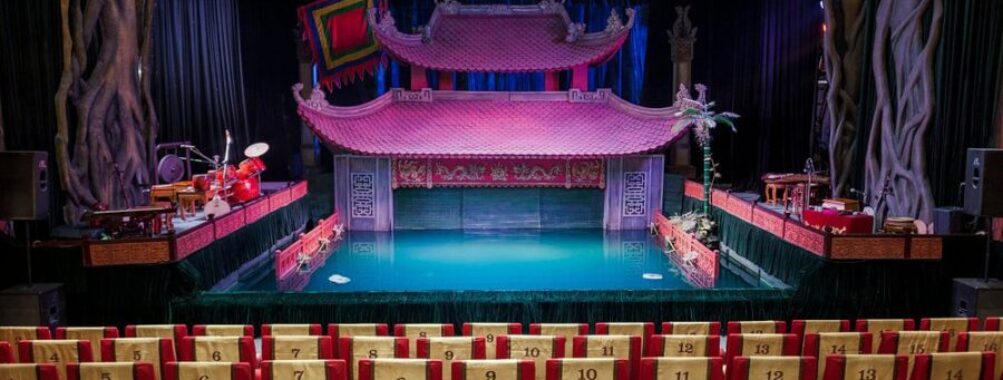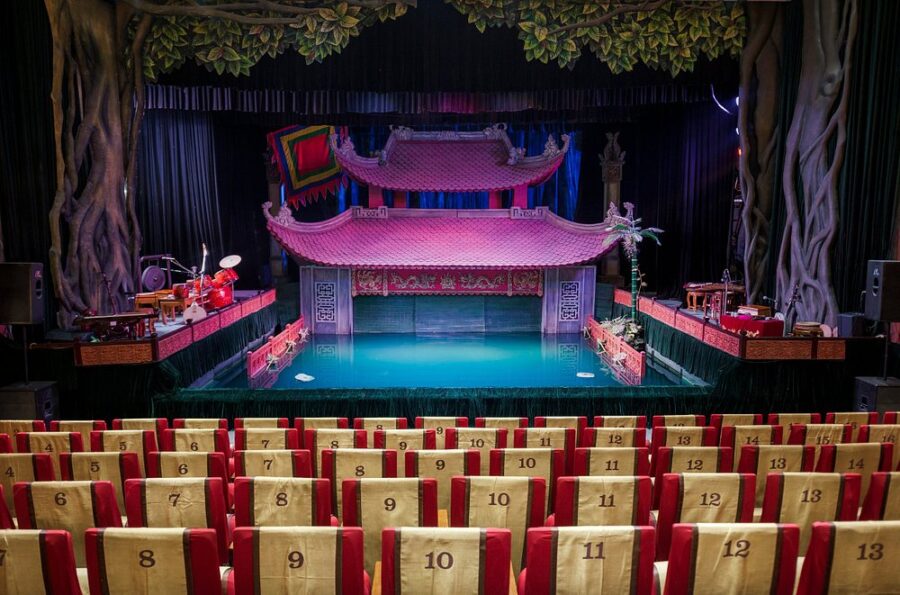
Thang Long Water Puppet Theatre
Table of Contents
History and Significance

The history of water puppetry in Vietnam dates back to the 11th century, originating in the Red River Delta. Can you imagine these performances being enjoyed for over a thousand years? This ancient Asian puppet tradition began as entertainment for villagers during the flooding of rice paddies. The pool of water became the stage, and the puppets, crafted from wood, came to life. These performances were not just shows; they were a way to celebrate the harvest and village life. The puppeteers, hidden behind a screen, manipulate the wooden puppets with incredible skill, bringing to life stories of daily life, folklore, and legends. The art form has been passed down through generations, preserving the essence of Vietnamese tradition. It is a traditional show.
Main Attractions and Activities
The Thang Long Water Puppet Theatre offers traditional Vietnamese water puppetry performances. The Thang Long Water Puppet Show features a variety of acts, often depicting scenes from rural life, such as farming, fishing, and festivals, and showcases Vietnamese folk tales. One of the most iconic characters is Tễu, a jovial and mischievous clown who often acts as the master of ceremonies. The Vietnamese orchestra provides live music, enhancing the experience with traditional sounds. The puppeteers, hidden behind a screen, use bamboo rods and strings to control the wooden puppets on the water’s surface. To fully enjoy the show, it’s best to get tickets in advance, as the theatre is a popular attraction. You can visit it at 57 B Dinh Tien Hoang Street. It’s an experience that will stay with you long after the curtain falls!
Visitor Experience
Visiting the Thang Long Water Puppet Theatre isn’t just seeing a show; it’s immersing yourself in Vietnamese culture. From the moment you step into the theatre, you’re surrounded by an atmosphere of anticipation and excitement. As the Vietnamese orchestra begins to play, the stage, a pool of water, comes to life. The wooden puppets glide effortlessly across the surface, telling stories that have been passed down through generations. You will witness the ancient Asian puppet tradition. Each water puppet show at the Thang Long Water Puppet Theatre is unique. The skill of the puppeteers, hidden behind a screen, is truly remarkable. The vibrant colors, the traditional music, and the captivating narratives create an unforgettable experience. The famous Tễu, the mischievous clown, often steals the show with his antics. The whole performance will leave you in awe of the traditional art of water puppetry.
Tips for Visitors
If you’re planning a visit to the Thang Long Water Puppet Theatre in Hanoi, some planning will make the experience even better. I cannot stress enough getting tickets in advance, especially during peak season, because the Thang Long Water Puppet Theater is super popular. You can purchase tickets online, and this will save you from queuing. The theatre is located at 57 B Dinh Tien Hoang Street, near Hoan Kiem Lake in the Old Quarter, making it easily accessible. Arrive early so you can soak in the atmosphere and maybe grab a good seat. The water puppet show typically lasts about an hour, so it’s a great addition to your day in Hanoi. Also, make sure to explore the Hanoi Old Quarter before or after the show, to truly appreciate the local culture. And don’t forget your camera to capture the memories of this unique cultural experience. You’ll be in the heart of Hanoi.
Accessibility and Facilities
The Thang Long Water Puppet Theatre aims to be accessible to all visitors, but given that it is an older establishment, certain limitations may exist. The theatre offers facilities such as restrooms and seating. The auditorium is designed to provide good views of the water puppet stage. However, if you have specific accessibility needs, it’s a good idea to contact the theatre in advance to inquire about accommodations. Being close to Hoan Kiem Lake and the Hanoi Old Quarter, the theatre is surrounded by various amenities. The location makes it easily reachable by public transportation or taxi. The staff is generally helpful and can provide assistance. The Thang Long Water Puppet Show is a piece of Vietnamese tradition. Remember, experiencing Vietnamese water puppetry at the Thang Long Water Puppet Theatre is more than just watching a show; it’s a chance to connect with the unique cultural heritage of Northern Vietnam, dating back to the 11th century and the Red River Delta. You’ll love it.
Unique Features
What truly sets the Thang Long Water Puppet Theatre apart from other theatrical experiences is its unique cultural significance and the mesmerizing art form of water puppetry itself. Imagine, instead of a traditional stage, a pool of water becomes the setting for intricate stories brought to life by wooden puppets. The puppeteers, hidden behind a screen, use bamboo rods and strings to control the Vietnamese water puppets, creating an illusion of graceful movement on the water’s surface. This ancient Asian puppet tradition, originating in the Red River Delta, is unlike anything you’ve likely encountered before. The performances often feature traditional Vietnamese folk tales, and the Vietnamese orchestra adds to the atmosphere, giving it an authentic touch. And the famous Tễu, that mischievous clown, adds an element of humor and fun! This isn’t just a show; it’s a window into Vietnamese culture, a celebration of tradition and artistry, and it’s a great place to experience a truly unique cultural moment.
Overall Impressions
My overall impression of the Thang Long Water Puppet Theatre is overwhelmingly positive; I think you’ll feel the same. It’s more than just a show; it’s an immersive experience that transports you to the heart of Vietnamese culture. The skill of the puppeteers, hidden behind a screen, is truly remarkable; the way they bring those wooden puppets to life on the pool of water is magic. The traditional Vietnamese music adds another layer of depth to the performances, making it a feast for the senses. While the stories are simple, they are engaging and provide a glimpse into Vietnamese folklore and daily life, dating back to the 11th century. I’m a bit of a history nerd myself and found myself in awe of how much of an impression water puppetry has left on Northern Vietnam. The Thang Long Water Puppet Theater provides a captivating and unforgettable experience, and one that I would recommend to anyone visiting Hanoi and seeking to explore the traditional art and history of the Red River Delta. Trust me, it’s a must-see!
Pros and Cons
Like any experience, the Thang Long Water Puppet Theatre has its pros and cons. On the plus side, it offers a unique cultural experience, showcasing an ancient Asian puppet tradition. The Vietnamese water puppetry art form is visually stunning, and the performances are engaging and entertaining. The theatre’s location near Hoan Kiem Lake and the Hanoi Old Quarter makes it easily accessible. Securing tickets in advance is a definite must to avoid any disappointment. However, the language barrier can be a challenge for some viewers. Also, the theatre itself is an older establishment, so accessibility may be limited for those with mobility issues. And, while the show is relatively short, some might find the stories repetitive. Overall, the pros far outweigh the cons, especially if you appreciate traditional art and Vietnamese culture. If you enjoy the water puppet show, then I encourage you to check out other areas of traditional Vietnamese culture and history in the Hanoi Old Quarter so that you can get the full Vietnamese cultural experience.
Location
Places to Stay Near Thang Long Water Puppet Theatre
Find and Book a Tour
Explore More Travel Guides
No reviews found! Be the first to review!